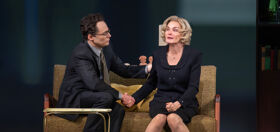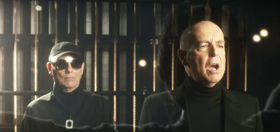Among the 25 films that have been inducted into the National Film Registry of the Library of Congress this year are Portrait of Jason, a 1967 non-fiction film about a gay hustler, and Top Gun, a 1986 blockbuster starring Tom Cruise as a young pilot that has become regarded for its perhaps unintended homoerotic subtext. Film are selected based on how they “epitomize the diversity and richness of the nation’s cinematic heritage” and “have been identified as motion pictures that deserve to be preserved because of their cultural, historic or aesthetic importance.”
About Portrait of Jason, the Library notes:
In one of the first LGBT films widely accepted by general audiences, Shirley Clarke explored the blurred lines between fact and fiction, allowing her subject, Jason Holliday (né Aaron Payne), a gay hustler and nightclub entertainer, to talk about his life with candor, pathos and humor in one 12-hour shoot. Clarke originally envisioned Jason as the only character, but she subsequently revealed: “When I saw the rushes I knew the real story of what happened that night in my living room had to include all of us [the off-screen voices. her crew and herself], and so our question-reaction probes, our irritations and angers, as well as our laughter remain part of the film.” Bosley Crowther of “The New York Times” described it as a “curious and fascinating example of cinéma vérité, all the ramifications of which cannot be immediately known.” Legendary filmmaker Ingmar Bergman called it “the most extraordinary film I’ve seen in my life.” Thought to have been lost, a 16 mm print of the film was discovered at the Wisconsin Center for Film and Theater Research in 2013 and has since been restored by the Academy Film Archive, Milestone Films and Modern Videofilm.
Jason and Shirley, a narrative film about the making of the classic documentary, played queer film festivals earlier this year.
Top Gun was originally considered a mega-hit that helped boost Cruise to his status as a top box office draw, as well as inspired young people to enlist in the military at a time when recruitment was at an all-time low. Then in 1994 a young actor-filmmaker named Quentin Tarantino unleashed a torrential monologue on the movie’s queer appeal in a costarring role in the 1994 rom-com Sleep With Me and Top Gun‘s legacy was forever changed.
How about we take this to the next level?
Our newsletter is like a refreshing cocktail (or mocktail) of LGBTQ+ entertainment and pop culture, served up with a side of eye-candy.
Watch Quentin explain Top Gun‘s subtext:
Other films added include the 1997 crime drama L.A. Confidential, which featured a subplot about homophobia within the entertainment industry, 1966’s Seconds, a gripping drama that allowed Rock Hudson to demonstrate his underrated acting skill, and 1959’s Imitation of Life, a tearjerker that’s long been a favorite of queer viewers.
Watch the trailer for Portrait of Jason below and the famed volleyball scene from Top Gun further down.
https://youtu.be/Zmfd9etbXGE” width=”420″ height=”315″ frameborder=”0″ allowfullscreen=”allowfullscreen”>





















Stache
I used to have such a crush on Val Kilmer.
Tom Greene
Johnnie Devine
Brian
Top Gun was not homoerotic at all. It was about straight-identifying men bonding over jets and women. Bonding between straight-identifying men is not homoerotic. The only people who think it’s homoerotic are desperate gay-identifying men.
Glenn Cheatham
Him in those BIG OLE PAIR OF GRANNY PANTIES???? No thanks!!!!!!
lauraspencer
I feel bad for the future if TOP GUN is considered worth preserving. If you had to choose a Cruise movie that symbolized a time and was a unique film experience that would be RISKY BUSINESS. The film launched Tom’s career and was a smart and slick new direction for teen films. How many times has the Cruise slide into the living room been copied?
Tom with his white briefs pulled up to his nipples in TOP GUN was no sexy and not worth saving for future generations.
1EqualityUSA
The “n” was missing on the marquee, so “Top Gu ” was what my brothers and I had called it. The name is permanent.
Captain Obvious
@Brian: Nice troll, even straight guys call the movie gay… and watch it anyway.
russellhm
This discussion reminds me of the 1995 documentary, “The Celluloid Closet,” which includes strong evidence that “Ben Hur” included a homoerotic scenario between Charlton Heston and Stephen Boyd. William Wyler, the director, discussed it with Stephen Boyd who went along with it but Wyler was advised NOT to mention it to Heston who would have “freaked” had he been made aware. It actually worked enough to suggest that our main characters, as friends from boyhood may have had a sexual relationship, innocent as it may have been and never pursue by Ben Hur as an adult but definitely by Massala.